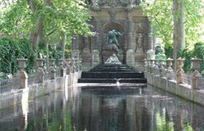Learning from an Illusion
October 12, 2011
0
Shares

 Maria de Medici moved from Florence to Paris in 1600 as the wife of Henri IV, King of France. Homesick for her native city and caught in an unsuccessful marriage, she pestered her husband to build her a mansion and grounds that would remind her of thepalaces she’d experienced as a child in one of the great families of the Italian Renaissance.
Maria de Medici moved from Florence to Paris in 1600 as the wife of Henri IV, King of France. Homesick for her native city and caught in an unsuccessful marriage, she pestered her husband to build her a mansion and grounds that would remind her of thepalaces she’d experienced as a child in one of the great families of the Italian Renaissance.On a trip to Paris a while back, I stumbled upon a fountain in the Luxembourg Gardens, now a public park that makes up the grounds for what was once Maria de Medici’s Luxembourg Palace (a building that now plays host to the French Senate).
The garden’s baroque fountain was built in 1625. Designed by engineer Florentin Thomas Francine, it includes three niches with a pediment ornamented with the crests of the French king and his queen’s Italian family. By 1860, the fountain had been relocated and retrofitted, with Alphonse de Gisors restoring the coats of arms and adding a 50-meter water lane flanked by trees. The centerpiece sculpture from the original fountain was placed at the end of the lane.
I’ve never seen any discussion of the fountain’s most unique feature – that is, the illusion that it is out of level!
In examining the composition, you sense that the water alley pitches toward the back and is approximately three feet out of level across its length. We all know that water always seeks its own level, so we assume (with the aid of our gullible minds’ eyes) that things are out of whack.
I spent nearly an hour – in the rain, I must add – measuring the urns, pedestals and railings in an attempt to determine exactly how de Gisors carried off this optical illusion. I couldn’t figure it out at the time, but a few months later it dawned on me: He’d altered the horizon to trick the viewer’s peripheral vision, thereby fooling the mind’s eye.
When our perceived reality is manipulated in this matter, it is known as “forcing perspective” – and this fountain is the best public example of this trick that I’ve ever seen. The next time you’re in Paris, stop by to enjoy this visual treat.
Practical Applications
Through the years, I’ve used forced perspective on a number of occasions to achieve effects that meet my clients’ desires or a site’s requirements.
I have, for example, played with the refraction of light through water to create illusions that flatten curved surfaces (or curve flat surfaces). This comes into play, for example, with bowls of water: If the outside edges appear to be flat, our eyes tell us the bowl should not be able to hold water – and it works that way visually because the refracted image of the underwater structure only appears to be flat.
I’ve also used water’s ability to transmit light, illuminating thin sheets of water spilling over weirs to give the illusion that the water is lit by a horizontal ribbon of light – from no visible source. And I’ve suspended spilling vessels in mid-air, giving the illusion that they are levitating with no attached pipes or wires. Our brains say, “I see it, but I don’t believe it.”
To be sure, developing such effects can take many mock-ups and lots of trial and error, but it’s great if you hit on the right combination of angles, finishes, proportions and depths to create them. And it’s extremely satisfying to see people react the first time they see these effects – and then watch them try to figure things out for themselves!
.
Paolo Benedetti is principal at Aquatic Technology Pool & Spa, a design/build firm based in Morgan Hill, Calif. He may be reached at [email protected].









